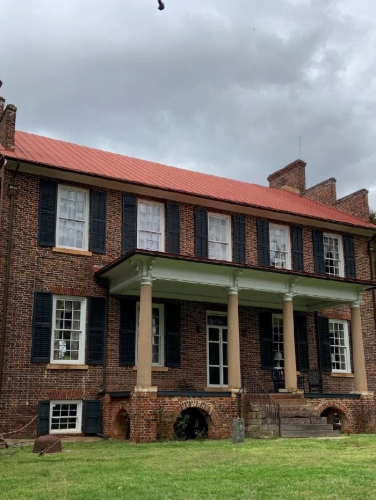
Cedar Grove
(ca. 1833)
Mecklenburg County’s largest plantation is a rare local example of the prevalent reliance upon enslaved labor across the South prior to the Civil War.
8229 and 8301 Gilead Road, Huntersville, NC 28078
Agriculture in Mecklenburg County during the 18th and 19th centuries was primarily small-scale subsistence farming. Plantations – defined by historians as large estates where at least twenty enslaved persons cultivated one or more commodity or “cash” crops – were rare, concentrated primarily in the county’s northwestern section. From approximately 1790 to 1847, the family of Hugh Torrance (1743-1816; also spelled Torance and Torrence) assembled the county’s largest plantation, culminating in the construction of the Cedar Grove house by Hugh’s only son James Galbraith Torrence (1784-1847) between 1881 and 1883. At its peak, Cedar Grove produced some 45,000 pounds of cotton annually and included a grist mill, sawmill, and several cotton gins, all dependent upon the use of enslaved labor.
Property Quick Links
One hundred and nine enslaved people lived and worked on the over 3,200-acre Cedar Grove estate as of 1847. Although enslaved labor was used throughout North Carolina, that was an unusually large number for a single Piedmont plantation, representing a concentration of wealth uncommon for this area. Over 70% of North Carolina’s total enslaved population lived in the eastern coastal plains. Less than 3% of the state’s enslaved African Americans lived on plantations with populations exceeding 50 enslaved people.
Hugh Torance, an Irish immigrant and Revolutionary War veteran who came to Mecklenburg County in the late 18th century, started in the mercantile trade, operating a store in Rowan County. He married Isabella Kerr Falls (1740-1816), a widow with eight children. Soon after the birth of James, the only child the couple had together, the family moved to Mecklenburg County to occupy and operate the nearby Hugh Torrance House and Store. At the time of his death, Hugh had acquired over 1,400 acres of land, becoming one of the area’s largest planters. In addition to cotton, Hugh raised a substantial number of livestock. Following Hugh’s death, James acquired all of his father’s Mecklenburg County property and continued to operate a dry goods store that he opened in 1805. James sold the store in 1825 to focus on operation of the family estate, which he more than doubled in size during his lifetime, primarily cultivating cotton, corn, and wheat.
Married three times – the first two marriages ending in the premature deaths of wives Nancy Davidson and Mary Latta – James had the Greek Revival style Cedar Grove built for his third wife, Margaret Allison, on the same site as a brick house built by Hugh in 1784. Much of the lumber for Cedar Grove was harvested and processed onsite by James’ sawmill. More than 20,000 bricks for the house were also crafted onsite. Much of the construction work was completed by enslaved persons under the supervision of craftsmen hired by James. Following James’ death, Margaret managed the estate until her own death in 1880 with the assistance of her sons Richard and John, hiring overseers while her sons served in the Confederate forces during the Civil War. The abolition of slavery created labor shortages that required Cedar Grove and other large-scale agricultural operations to employ tenant farmers and sharecroppers, a solution that ultimately proved unprofitable for the Torrance family. In the late 1920s, the family estate was divided into parcels and distributed to surviving family members.

